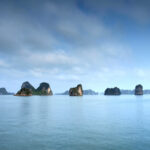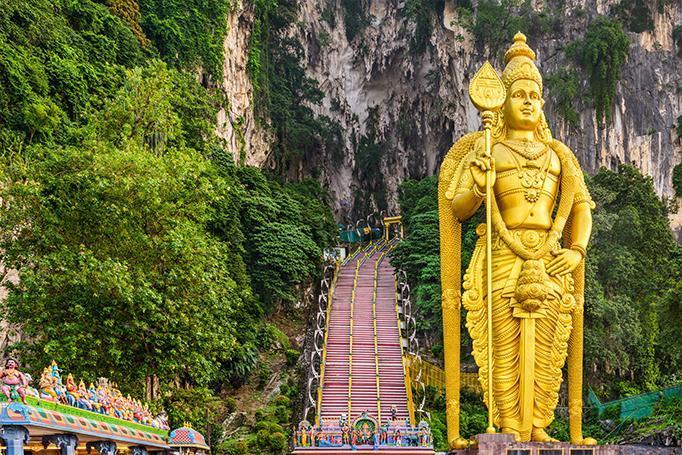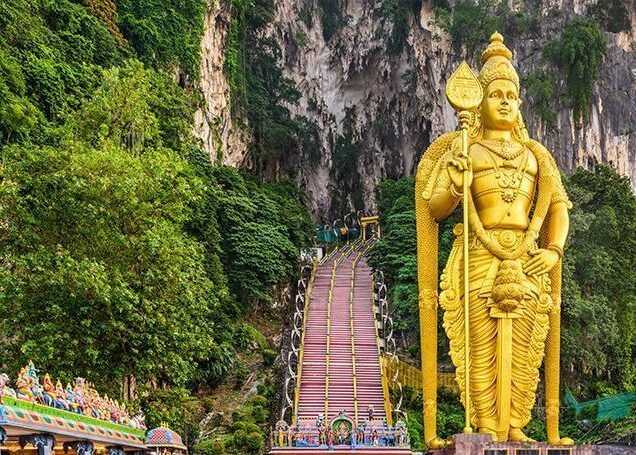
Ha Long Bay
A must-see in Vietnam Often listed as a must-see in Vietnam, Ha Long Bay (Vịnh Hạ Long) is stunning. Covering an area of 65, 650
Malaysia is always a firm favourite with our travellers. A Malaysia adventure tour combines the architectural feats of Kuala Lumpur with the simplicity of life in the Cameron Highlands. This highland region sits at around 1,500 metres above sea level and was named after William Cameron, a British colonial government surveyor.
On our Malaysia adventure tours you have the option to take a jungle trek amongst the cool, refreshing forest air. The region‘s fertile mountain slopes make it one of the best places in the country to grow tea. In contrast KL as it is affectionately titled is a major tourist hub with international hotels, shopping and the famous Petronas Towers, which currently holds the title of the world’s tallest twin tower building. On a Malaysia adventure tour we also visit the less touristic areas of Penang and Melaka. In Penang we stay in Georgetown, an area known for its diverse architecture and culture. You can explore the gardens, temples or take the funicular to Penang Hill. During the 16th century, Melaka was reputedly the foremost maritime trading centre in the region.


A must-see in Vietnam Often listed as a must-see in Vietnam, Ha Long Bay (Vịnh Hạ Long) is stunning. Covering an area of 65, 650
Blessed with a consistent climate, abundant coastline littered with beautiful beaches and islands and a vibrant and diverse culture, it is little wonder Malaysia makes it on to the list for many travellers. Malaysia is one of the world’s megadiverse countries due to the massive number of plant and animal species that call this part of the world home. Natural features such as some of the biggest cave systems in Southeast Asia, dense jungle and colourful coral reefs are another feature of this nation. In addition colonial cities with World Heritage status add a splash of culture and history in a nation that is bursting at the seams with wonders.
The currency of Malaysia is the Malaysian ringgit (symbol: RM), which is made up of 100 sen. Bank notes coming in 1, 5, 10, 50 and 100 ringgit denominations and coins come in 5, 10, 20 and 50 sen denominations. If you are travelling outside cities, have plenty of small bills as anything larger than a 10 may not be accepted.
ATMs are plentiful and should accept major international cards such as Visa and Mastercard. The most common ATMs belong to Maybank or Public Bank. Exchanging cash in Malaysia is very easy and foreign exchange booths and commonplace. Most money changers do not charge a fee, but the rates vary so check the exchange rate before you change your money. Major brands of travellers cheques should be accepted in big cities and tourist sites, but not necessarily in more remote locations.
Malaysia is an inexpensive country to visit and can cater to all budgets. Food is inexpensive and varied and you can usually get a basic meal from a street vendor or local restaurant for US$3 or more. At the other end of the scale, international cuisine is available for much the same prices you would pay in any city in the world. A can of beer is usually around US$2-4 depending on location.
Malaysia’s largest urban area and also its national capital is Kuala Lumpur, located roughly halfway down Peninsular Malaysia near the west coast. North of Kuala Lumpur towards Thailand, Georgetown is a World Heritage listed colonial city and capital of Penang Island. Nestled near the border, the island of Langkawi has luxury resorts and beautiful beaches. On the eastern side of the peninsula near the Thai border, Pulau Perhentian are two white-sand tropical islands famous for their laid-back atmosphere. In the far south, Johor Bahru is the border town before Singapore.
On Malaysian Borneo, Kuching is the largest city and the state capital of Sarawak. Kota Kinabalu is the next largest city and the state capital of Sabah. Also in Sabah, Sandakan is a port city with an airport, close to the famed Sepilok Orang-utan Sanctuary as well as the mouth of the Kinabatangan River.
Electricity supply in Malaysia is 240 volts and the most common plug socket is for three square-prong plugs such as that used in the United Kingdom, they may also accept two round-prong plugs such as those used in Europe. If in doubt, take a universal adaptor to cover your bases.
Malaysia’s population is comprised of majority ethnic-Malay and sizable Chinese and Indian minorities. There are significant differences between the business-minded hustle of the cities and the countryside. In rural areas, Malay culture is more prevalent and Islamic faith more noticeable. In Malaysian Borneo there are communal tribes which still exist, living in jungle longhouses.
Malaysia’s national language is Bahasa Malaysia, or Malay. In addition there are Chinese dialects, Hokkein, Cantonese, Mandarin, Tamil and other India languages spoken in the country. English is also spoken, but may be the unfamiliar sounding Malaysian patois known as Manglish.
Most Malays are Muslim, Chinese usually follow a mix of Buddhism, Confucianism and Taoism and Indian communities are generally Hindu. Malaysia is a country of religious freedom allowing people to worship as they please.
When eating at a Malay restaurant wash your hands first using water from the teapot on the table over the tray. As in many cultures, Malay people only eat with their right hand, their left is reserved for toilet business. Pork is forbidden for Muslims; do not offer or mention pork to Muslim people and do not offer them alcohol.
The country of Malaysia include the Malay peninsula (except Singapore) and the north and north-western part of the island of Borneo (except Brunei) making up a total land mass of 329,758 square kilometres. Peninsular Malaysia is mostly covered by dense jungle, is mountainous in the north and has a long fertile plain running along the west side. Its abundant coast is fringed with sandy beaches and littered with islands, especially along its eastern side.
The other half of its land area, comprising over 50% of the country’s total size, is on the island of Borneo. There are two Malaysian states on Borneo, Sabah and Sarawak. Both are blanketed in thick jungle fed by large river systems. Sabah is home of the famous Mt Kinabalu which at 4095 metres is Malaysia’s highest mountain.
One of the earliest kingdoms in the region was Langasuka, believed to be located in the modern state of Kedah in what is now the far north of the country, from around the 2nd century AD. They were eventually absorbed by first the Funan Empire in the north, then the Srivijaya Empire in the south. Between the 7th and 13th centuries, the Buddhist Srivijaya Empire rose to rule the Malacca Straits, Java and south Borneo.
In the late 14th century, Parameswara, a renegade Hindu prince from Sumatra, arrived at Melaka and saw it had great potential as a deep water port. Establishing the Melaka Empire, he sent envoys to the Chinese and under their protection Melaka became a major trading port owing to its convenient location halfway between China and India.
Islam came to the country via Indian Muslim traders and began to take root from the mid-15th century when the third ruler of Melaka converted and his son, Mudzaffar Shah, after him made Islam the state religion and took the title of sultan. The influence of the Melakan sultans expanded and they ruled over the greatest empire in Malaysia’s history.
The Portuguese, seeking to control the lucrative spice trade, sent a fleet of 18 ships in 1511 with which they defeated Melaka’s army. They built a fortress on the site and created a monopoly on trade, ruling for 130 years. Throughout this period there were many wars and skirmishes, such as with the Johor Empire, located in southern Peninsular Malaysia, who held out hope of recapturing Melaka.
When the Dutch arrived, they allied with Johor and based themselves in Batavia (Jakarta) in competition with the Portuguese. Together they attacked Melaka and captured the city in 1641. As reward for their cooperation, the Johor Empire was freed of trade tariffs and restrictions and rose to be one of the most powerful Asian powers in the region.
The British too, sought to gain a foothold in the region, establishing their first base in Penang in 1786. When Napoleon took the Netherlands in 1795, the British took control of Melaka and Dutch Java, fearing French influence in the region, before handing the area back to the Dutch when Napoleon was defeated. They then went on to establish Singapore as a major trading post, and in 1824 the Anglo-Dutch treaty was signed, dividing the region between the two powers, with the British controlling the Malay peninsula and Singapore and the Dutch holding Indonesia. This agreement did not include the island of Borneo where British adventurer James Brooke rose to power through negotiation and naval force, becoming the raja of Sarawak where he ruled until the Japanese arrived during World War II.
The Japanese arrived in Malaysia in 1941. Within months they had taken the peninsula, followed by the island of Borneo. During their brutal occupation, thousands were executed and many more imprisoned or pressed into harsh labour, before the Japanese surrendered to the British in Singapore in 1945.
After World War II the region fell into turmoil. The British attempted to amalgamate the regional sultans into one Malayan Union, centralising authority. North Borneo and Sarawak became British Borneo. The people did not accept this and the country’s first political party was formed. The Malay Union was revoked and the Federation of Malaya declared in 1948. With this the sultans retained their sovereignty and Malay citizens were given special privilege. This angered the Chinese population who turned to the Malay Communist Party in the hope of an equal society. Labelled the Emergency by the British, the rift led to full-blown civil war until the communists were forced out in the north towards the Thai border, with the Emergency declared over in 1960.
The British promised independence within two years in 1955, held an election and on August 31 1957 Merdeka (independence) was declared. In July 1963 Malaysia was born by the fusing of Malaya, Singapore and the states of Sabah and Sarawak in northern Borneo. This was done so that the balance of ethnic Chinese in the new nation did not outnumber the Malaysians. It caused major issues however; the Indonesians tried to claim the entire island of Borneo (unsuccessfully) and the sultanate of Brunei, although originally intending to be part of Malaysia, decided at the last minute to retain independence. Without Brunei, Chinese outnumbered Malaysians due to the high number of Singaporean Chinese and Singapore was ejected from the federation. Ethnic tensions continued in Malaysia with the government attempting to preserve Malay culture and language, while the Chinese population fought to retain their Mandarin-speaking schools. Chinese and foreign companies held much of the country’s industry, sparking riots and violence. A policy of positive discrimination began, to shift more of the corporate wealth into the hands of ethnic Malays.
We are passionate adventure travelers who want to share the world and our travel experiences with everyone…
This website uses cookies so that we can provide you with the best user experience possible. Cookie information is stored in your browser and performs functions such as recognising you when you return to our website and helping our team to understand which sections of the website you find most interesting and useful.
Strictly Necessary Cookie should be enabled at all times so that we can save your preferences for cookie settings.
If you disable this cookie, we will not be able to save your preferences. This means that every time you visit this website you will need to enable or disable cookies again.

